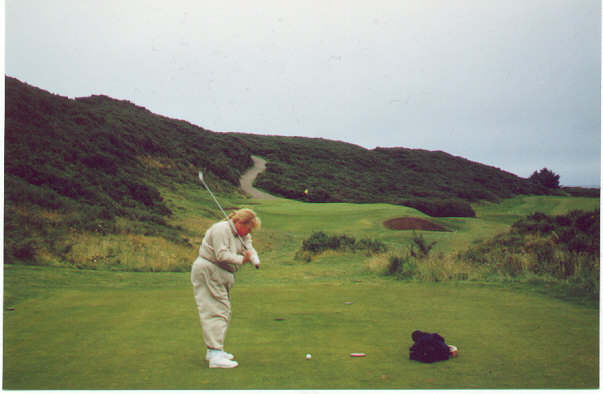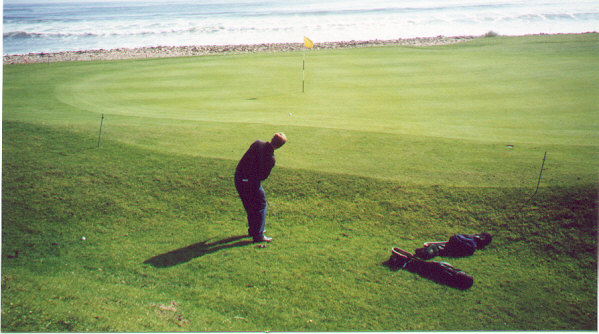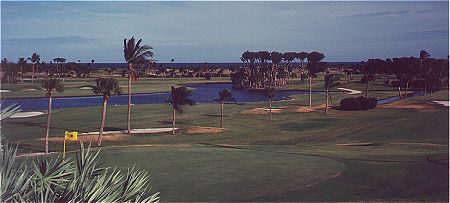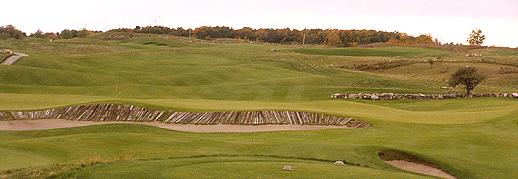Feature Interview No. 2 with Lorne Rubenstein
January, 2002
Lorne Rubenstein has written a golf column for The Globe and Mail, Canada’s national newspaper, since 1980. He’s written eight books, including Links: An Insider’s Tour Through the World of Golf, and books with the late Canadian golfer and master ball-striker George Knudson, Nick Price, and David Leadbetter. Lorne hosts Acura World of Golf, Canada’s longest-running golf show on television; it’s on The Sports Network. He writes a regular column for ScoreGolf, a national publication in Canada, and has written for magazines around the world, including Golf Digest, Golf Magazine, Golf Journal, Links, Esquire, T&L Golf, and Cigar Aficionado.
In 2000, having visited Scotland some 20 times, Lorne decided to spend a summer in Dornoch in the Scottish Highlands. He had been to Dornoch once before, in 1977; the landscape, the people and the course stayed with him, and he wanted to return to a place where golf was a focal point of most everybody’s life.
Lorne and his wife Nell rented a flat above the Dornoch Bookshop, steps from the Royal Dornoch Golf Club. His latest book A Season in Dornoch: Golf and Life in the Scottish Highlands (Simon & Schuster (U.S.), McClelland & Stewart (Canada), is an account of that summer.
(1) How did you determine to spend the summer of 2000 in Dornoch?
I’d first visited Dornoch in 1977, when I meant to stay for a day and stayed a week. The place imprinted itself on my mind. After some 25 years of covering golf around the world, I wanted to spend three months in a quiet, small village that had one of the best links anywhere. I’d visited Scotland some 20 times since 1977, but hadn’t returned to Dornoch. It was the only place I considered for our summer in Scotland.
(2) How much has Dornoch changed from your first visit in 1977 until your most recent visit?
Dornoch hasn’t changed much at all, except for some added housing in the upper part of the village and a few homes alongside the west ridge overlooking the North Sea and the links.
(3) How have the villagers coped with the fame that has come to Dornoch, especially in the past decade?
They’re not that impressed by anything, except, of course, that they understand that the place thrives because of the visiting golfers. There’s always a bit of tension between the locals wanting Dornoch to remain a place remote from the rest of the world, and those who want people to visit it en masse. This tension was best expressed when Madonna visited a few months after our stay. Dornoch filled with 1,000 journalists come to record the christening of Madonna and Guy Ritchie’s son Rocco, and their wedding at nearby Skibo Castle. People were alternately excited and bored by the visit, and were happy to return to their quiet way of life when Madonna and her entourage left.
(4) Are the locals distinctive in any particular way from other towns in Scotland?
Given the relatively small number of permanent residents-some 1,300-Dornoch can in the summer seem overcome by visitors. Many of these visitors spend the entire summer, or longer, there, and have homes in the village. They’re known as ‘incomers,’ a term that suggests there are two categories of people in Dornoch: Those who are locals and those from away. Yet, if anything, the permanent residents-the Highlanders-manage to retain their distinctive humor, independence and, even, their reticence. They are skeptical by nature of people who would like to bring their outside ways to the village, but they soon warm to you. You have to prove yourself, to show that you have come to Dornoch because you want to experience their way of life, not to transport yours there. There’s always a feeling that Dornoch and Dornochers are indeed outside the mainstream, which I found an attractive quality; for instance, the Open Championship was really the only tournament they cared about, except, of course, for the annual Carnegie Shield at Royal Dornoch. That’s a major in Dornoch.
(5) What are the locals’ favorite games?
They love their Stablefords, or what we call quota-points. The head pro Andrew Skinner has a Thursday Stableford in the winter, and it’s always popular no matter the conditions. And of course they play plenty of match play, and doing so changes the way one might approach a hole. The par-three second is a good example; if your opponent has hit his tee shot into the deep pot bunker to the left, where he might not even get it out over the steep face, you might hit your shot intentionally short of the green, then pitch up to be certain of your bogey and perhaps make a par.
(6) What exactly is Donald Ross’s connection to Dornoch?
Ross was born in Dornoch in 1872, just down the road from the flat we rented during our summer there. He walked the links every day, and at first worked for a local carpenter who made the wooden boxes that held the sand that golfers used to make tees. He also learned some greenkeeping and clubmaking, and, after club secretary John Sutherland sent him to the Old Course to work under Old Tom Morris, he returned to Dornoch in November 1893. Sutherland soon hired him as the club’s pro, greenkeeper and clubmaker. Ross in Dornoch absorbed many of the principles of course design that he would bring to the U.S. after he left Dornoch in 1899. He returned from time to time, and while the villagers haven’t always remembered him with great affection-he did leave to make his living elsewhere, after all-still there’s no denying that he was always a Dornoch man.
(7) Which is the most dangerous one-shotter at Royal Dornoch?
The sixth can be frightening in any sort of wind. The green at the 163-yard hole is long and skinny, and sits up against the high ridge that dominates the left side of the links going out. Pot bunkers protect the left side as well, while the green falls off into space all along the right side; one of the worst Dornoch feelings is to see one’s ball hitting the green on the right side and then spinning further right and down the nearly vertical slope. Now the golfer is faced with either slamming the ball into the hill and hoping he gets just the right number of bounces and ‘kill the speed’ action on the shot, or lofting the ball onto the green. This last shot is next to impossible when the grass is trimmed to the brown bone, as greenkeeper Bobby Mackay likes it.

The 6th is fraught with danger.
(8) Which is the most underrated hole at Dornoch?
You don’t hear many people talk about the 11th, but it’s a superb 450-yard par-four that presents all sorts of subtle and not so subtle problems. Miss the wide fairway left and you’re in high fescue. Miss right and you might not find your ball in the gorse, or be able to do nothing but pitch back to the fairway. Then there’s the bunker that eats into the right side of the green-it’s really part of the green-and the fall-off at the left side of the green. The hole appears big and wide, but its size conceals its artistry. I might mention that the fairway is knobby and rumpled as an unmade blanket, which is as it should be.
(9) What was your biggest surprise, from a golf perspective, of your time in and around Dornoch?
I wasn’t so much surprised as I was taken by how well Dornoch had managed to resist the worst of modern golf, despite the dramatic increase in visitors since I’d last visited there in 1977. People still walked and walked briskly, and carts were still unseen forces except for the odd visitor who needed one for medical reasons, and had to have a doctor’s note to get one. The locals weren’t all that impressed with modern equipment, and chuckled at the very idea of spending a small fortune on drivers; many didn’t even know about the latest and supposedly greatest golf ball. And the members wanted their course to play as firm and fast as possible. Visitors, I noticed, soon came to agree with these ideas. Of course just the fact that they had come to Dornoch suggested they were of the right caste of golfing mind and spirit for the game there. But it surprised me how quickly they dropped their modern ways, and willingly submitted to the charms of the old game.
(10) What was your favorite hole at Dornoch before your summer there? And after?
My favorite hole before was the third, simply because when one walks off the second green and turns around the hedge there, suddenly the most magnificent view presents itself on the third tee. It seems that the world is there for the viewing, and golf as it should be-a game on open ground with a sea-view-presents itself. The third also happens to be a fine hole, where the fairway cants to the right and the bunkers on the right, while seeming far off the line of play, are in fact well in play. And the green sits there, open and inviting, yet rejecting shots as well as attracting them. I always liked the way this hole encompasses what links golf is all about.
By the time I’d left I’d come to love the 13th, a short par-three near the North Sea where the wind often howls. One evening I hit a series of shots to the green, which is set at an angle to the tee. The wind was blowing hard across the green from the sea, and I hit a variety of shots with different clubs-holding shots against the wind, riding the wind, hard hooks on the wind. I could have stayed there all evening, because there were so many ways to play the hole in what I’ve described in A Season in Dornoch as ‘full conditions.’ The 13th is a small, refined gem-a near-oval green set among elements both harsh and beautiful, depending on one’s perception and imagination.
(11) The 9th and 12th at Dornoch are often played as two-shotters for visitors. How do you react to this policy?
Well, I don’t recall this happening during the three months I spent in Dornoch. Visitors and members alike play the same tees of the day. These aren’t the medal or farthest back tees unless a medal competition is on, but still the ninth and 12th played as par-fives. They’re shortish par-fives, yes, but then again par and yardage means less on a links because the wind is such a factor. I’d prefer to play the 12th in particular from the rearmost tee, which is set back in the dunes and slightly elevated above the beach so that you can see the ocean. The hole is also much more of a dogleg left from that tee, and a very different hole because you’re hitting across the rough rather than straight down the fairway. I do wish that visitors and members alike had the choice of playing whatever tees they’d like, and have argued this in articles and in conversations with club secretaries and club captains for years. But things are slow to change in Scottish golf, and even slower in the Highlands. That’s usually a good thing, but perhaps in this area better golfers should be allowed to play off the medal or back tees.
(12) If you were given 100 rounds of golf to play in one year within 30 miles of Dornoch, including Royal Dornoch, which would you play and how many rounds at each?
Royal Dornoch: 70
Brora: 10
The Carnegie Club, Skibo: 10
Golspie: 5
Tain: 5

Brora is a classic out and back links. The 9th green is hard by the water.
(13) What impresses you about Steel/Mackenzie’s work at Skibo?
They use the big, open spaces so well to frame holes, provide views and give one that essential feeling of roaming in landscape. Steel and Mackenzie (and Martin Ebert, another associate in the office, but who didn’t work on Skibo) also know how to use a minimal amount of bunkers to get maximum effect; they’re able to threaten the golfer with the slope of the ground into the pot bunkers without imposing cavernous bunkers on the ground. They also have a real feeling for green sites, and some at Skibo are memorable for the ways in which they sit on high points. The only problem with Skibo is that environmental restrictions kept Steel and Mackenzie from doing all they’d like, so a few holes at the end of the front side and the start of the back are located in what amounts to an open field. At the same time it’s interesting to see just what they can do with flat land. Steel has always believed, as have the finest classic architects, that it’s possible to build excellent holes on ground that moves only a little, if at all.
(14) How would you rate the merits of Brora vs. those of Tain?
Brora is wild, rugged golf while Tain is more settled because it’s on softer land. Brora can sometimes feel like primitive golf, and I mean that in the best sort of way: It’s raw, untamed. a chunk of jagged land upon which architect James Braid placed a series of holes. The par-three sixth and 12th holes that play across the course at right angles from the sea mean that the golfer is faced with every wind possible, and blow it does. Of course there’s the often remarked ‘issue’ of the electrified fences around the greens that protect them from the sheep. Golfers would like to have the sheep removed, but land issue is a complex matter in the Highlands-as it should be. Land belongs to people who aren’t golfers too.

Any harsh evidence of man’s handiwork is joyously absent in this view of the 1st at Brora.
The Irish professional Ronan Rafferty has presented a plan to the Brora Golf Club to redo the course. As I recall, much of the routing remains the same-classic out and in except for the aforementioned cross holes. His plan will lengthen and strengthen the course. I only hope it remains as ‘primitive’ as ever.
As for Tain, it has its own charms. Tain is a links, of course. Tom Morris designed the course in 1890. Allan Ferguson, in his excellent book Golf in Scotland: A Travel-Planning Guide with Profiles of 60 Great Courses, writes that while Tain ‘will always be played in the shadow’ of Royal Dornoch, is still ‘one of the most unusual and enjoyable courses’ in Scotland. I agree: Tain offers so many pleasures, from the blind second shot over a tiny public road and a fence to a hidden green, out to open ground with wonderful views back to the town, burns and bunkers intriguing enough to interest any golfer with a penchant toward appreciating course architecture, and so on. (By the way, I recommend Ferguson’s well-written guide to anybody who wants to visit Dornoch; it’s informative and a treat to read; check out www.fergusongolf.com for more information.)
(15) What is the best time of year for an ardent golfer to visit Dornoch?
I’ll preface this by saying that many people are surprised to find that Dornoch’s climate is more temperate and milder than many areas of Scotland. For one thing, it’s protected from the rain that the west coast gets because of mountains that protect it from the storms that blow in from off the sea. Dornoch is on the lee side of these mountains, and so gets only 30 inches of rain a year. Glasgow gets 41; the northwest coast 120.
That said, of course Dornoch can have awesome weather-and by that I mean the full force of nature is applied to the area, and that one is in awe. It can be 70 degrees in mid-September, as it was when I was in Dornoch. Or it can be 45 degrees in late June, as it was when I was there. But in general, April through October are good golfing months, weather-wise.
I’d visit Dornoch in late April/early May, or late August into the second week of October. The weather should be more than decent, and the course and village won’t be as busy as in high summer.
But I wouldn’t worry too much about overplanning your itinerary. Times always open up in Dornoch and at nearby courses. Visit for a few days rather than rushing in and out as too many people do. Stay in the area, play all the courses. Have a Highlands experience, not a golf as boot camp experience.
(16) Taken as a set, where would you place the green complexes at Essex in Windsor, Canada amongst some of Ross’s other famous works?
It’s a while since I played Essex, but I wasn’t that impressed with some of the green complexes. As I recall, they’d been modified over the years and many weren’t really even Ross greens anymore. As far as Ross greens go, well, you can’t do better than Seminole or Pinehurst #2. In A Season in Dornoch I write that Seminole reminds me more of Royal Dornoch than any Ross course I’ve played. It’s got that big, open feeling, and a wonderful variety of both plateau greens and others settled down into the ground. The course also plays in what is essentially a bowl with flipped or raised edges in places. It’s positively Dornochian.

Much of the course can be seen from behind the 2nd green at Seminole.
(17) What impresses you the most about Dana Fry’s work at the Devil’s Paintbrush? Describe your favorite hole at the Paintbrush and what you like so much about it?
The Paintbrush is tremendous even as it’s over the top in places. It’s bold and it’s brash and it’s outlandish. The landscape is lunar, as overworked a comparison as that is. I’ve just seen the 2002 calendar that features Paintbrush photography and a description of the topography as ‘outrageous.’ Dana and Mike Hurdzan weren’t afraid to let the holes rip and snort over the land and to let them be outrageous. The sixth green has a 12-foot change in elevation from front tier to back tier. An old foundation of a barn and cattle drinking trough splits the fairway on the par-five eighth hole, which the course pro Ben Kern describes as ‘cross-country golf.’ So all in all I enjoy the sprawling madness of the fairways and greens and hazards and the way the fescue fairways allow the ball to bounce. I only wish the course owners had gone along with Hurdzan and Fry and that they’d have allowed fescue rather than bent greens.
The seventh might be my favorite hole at the Brush, as locals call the course. It’s a 202-yard par-three from a slightly elevated tree to a wide green that sits in the hills, protected by deep pot bunkers front and read. Miss the green left and your ball can roll well back into the fairway. The hole is just a good-looking hole that’s right there in front of you-a counterpoint to some of the madness and mind-blowing features that make the rest of the course so much fun.

The Paintbrush possesses numerous features rarely found in North America. The view from behind the 9th green highlights several: wildly rolling fairways, planked bunkers and a shared green.
(18) Your wife, Nell, who is a non-golfer, accompanied you to Dornoch. What in the heck did she do? Are you still married?
Hey, I’m a lucky guy, and yes, we’re still married. Happily. Thriving too. Nell is an adventurer. She’s been to the Atacama Desert in Chile-the highest and driest desert in the world. She’s been to the Galapagos and Ecuador. Nell was really the guiding force behind my book, which is why my dedication reads ‘For, and with, Nell. She encouraged me to spend the summer in Dornoch and to write A Season in Dornoch because she felt I should do a more personal book after instructional books with Nick Price and David Leadbetter, both of which I enjoyed writing. But this was an immersion into a culture, a society, a way of golf and a way of life. Nell loves to hike, to cycle, to read. So what could be better than our living above the Dornoch Bookshop and making friends with the owners-they and the bookshop are part of A Season in Dornoch? Or what could be better than us having the Highlands to cycle and hike in, and to roam around? The local library was also right beside our flat, and Nell spent a lot of time in there learning about Scottish and Highlands history, which of course was of immense assistance to me when I wrote the book. As I say, ‘For, and with, Nell.’
The End





